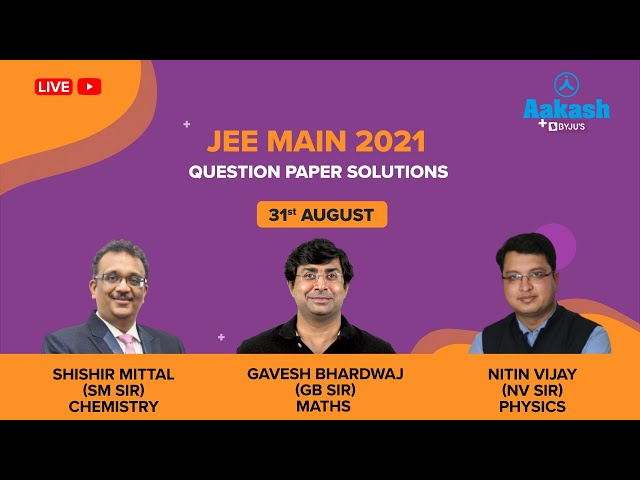Question 1:If
Answer: e2 / 16
=

Question 2: Find the value of
Answer:2x2/(1-x) + x + ln(1-x)
Let S =
= 2[x2 + x3 + ….∞] – [x2/2 + x3/3 + x4/4 + …∞]
= 2[x2/(1-x)] – [x + x2/2 + …. – x]
ln(1-x) = -x – x2/2 – x3/3 – x4/4 – …∞] = 2x2/(1-x) + x + ln(1-x)
Question 3: Solve
Answer: Solved below
Multiplying both the equations,
Comparing both the coefficients of x20 on both the sides,
Question 4: If
Answer: 2
Equation of tangent is
(x/b)cosθ + (y/2a) sin θ = 1
Area(ΔOAb)=(1/2)(2ab)(secθ csc θ)
Area = 2ab/sin2θ
Minimum area = 2ab (Therefore, θ = 45 degrees)
So, K=2
Question 5:If 2x – y – z = 3,x + y – 2z = α,3x + 3y – βz = 3 has infinite solutions, then find the value of α + β – αβ.
Answer: 1 + 6 – 6 = 1
Δ = 0
= 2(-β + 6) + 1(-β + 6) – 1(3-3) = 0
β = 6
Δ1 = 0
3(-β + 6) + 1(-αβ + 3) – 1(3α – 3) = 0+
Or α = 1
Therefore, α + β – αβ = 1 + 6 – 6 = 1
Question 6: The value of
a. 5
b. 8
c. 6
d. 10
Answer: (a)

Question 7: A wire of length 20 is cut into two parts one is made into a regular hexagon of side a and the other to square. Find ‘a’ if the combined area of a square and regular hexagon is minimum.
Answer: a = 10/(2√3 + 3)
4b + 6a=20
⇒ b=(20-6a)/4 = 5 – (3/2) a
A = b2 + (3√3 a2)/2
A = (5 – (3/2) a) 2 + (3√3 a2)/2
dA/db = 3√3a – 3/2×2(5 – 3a/2) = 0
⇒ 3√3 a + 9/2 a = 15
⇒ 2√3 a + 3a=10
⇒ a = 10/(2√3 + 3)
Question 8: If x2 + y2 + px + y(1 – p) = 0 is the equation of circle, r ∈ (0,5], q = p2 then number of integral values of (p,q) satisfy is
a. 16
b. 14
c. 19
d. 21
Answer: (b)
Let S : x2 + y2 + px + y(1 – p) = 0
r = √((p/2) 2 + ((1 – p)/2) 2 )
0 < (p2 + (1 – p) 2)/4 ≤ 25
⇒ 0 < 2p2 + 1 – 2p ≤ 100
⇒ 0 < 2p2 – 2p + 1 ≤ 100
⇒ ( – 1/4) < (p – 1/2)2 ≤ 199/4
⇒ (p – 1/2) 2 ≤ (√199/2) 2
Total number of integral pairs of (p,q) = 14
Question 9: In a certain biased die, the probability of getting a particular face is (1/6 + x) and the opposite is (1/6 – x) and 0 < x < 1/6. The probability for other faces is 1/6 each. The sum of opposite faces in a die is 7. If the probability of getting a sum 7 in a throw of 2 such die is 13/96, then x is.
a. 1/8
b. 1/12
c. 1/18
d. 1/20
Answer: (c)
For particular and opposite faces, if sum is 7.
Probability = 2(1/6 + x)(1/6 – x)
For remaining faces in two die, if sum is 7,
Probability = 2(1/6 x 1/6 + 1/6 x 1/6)
Given, 2[(1/6 + x)(1/6 – x) + 1/6 x 1/6 + 1/6 x 1/6] = 13/96
⇒ 1/36 – x2 + 2/36 = 13/(96×2)
⇒ 1/12 – x2 = 13/(96×2)
⇒ x2 = 1/12 – 13/(96×2) = 1/12 (1 – 13/16) = 1/12 ((16 – 13)/16)
Therefore, x = 1/8
Question 10:Find y(π) if y(0) = 7 and dy/dx = 2(y – 2 sin x – 10)x + 2 cos x
Answer: y(π) = 3eπ^2 + 10
dy/dx = 2(y – 2 sin x – 10)x + 2 cos x
dy/dx – 2 cos x = 2(y – 2 sin x – 10)x
(d/dx (y – 2 sin x – 10))/((y – 2 sin x – 10) ) = 2x
⇒ ∫d(y – 2 sin x – 10)/((y – 2 sin x – 10) ) = ∫2x dx
⇒ log |y – 2 sin x – 10| = x2 + C
At x = 0, y = 7
⇒ log |7 – 0 – 10| = 0 + C⇒ C = log 3
At x = π
⇒ log |y – 2 sin π – 10| = π2 + log 3
⇒ log ((y – 10)/3) = π2
⇒ y(π) = 3eπ^2 + 10
Question 11:If α, β are distinct roots of x^2 + bx + c = 0 then find
Answer: 2(β – α)2 = 2(b2 – 4c)
=
Let (x – α)(x – β) = y
then
Using L hospital rule,
=
=
This implies, 2(β – α)2 = 2(b2 – 4c)
Question 12:If (z + i)/(z + 2i) is purely real, then the locus of z is
a. x – axis
b. y – axis
c. y = x
d. y = x/2
Answer: (b)
(z + i)/(z + 2i) is purely real, so (z + i)/(z + 2i) =
⇒
⇒
⇒
z is purely imaginary
Therefore, z lies on y – axis.
Question 13:Tangent and normal at P(2, -4) to parabola y2 = 8x meet directrix at A and B. Q(a,b) is such that APBQ is a square. Find 2a + b.
a.-12
b.-16
c.-20
d.-18
Answer: (b)

y2 = 8x
⇒ a = 2
Tangent equation
-4y = 4(x+2)⇒ x+y+2 = 0
Normal: x-y+6 = 0
Directrix x+2 = 0
A = (-2, 0), B = (-2, -8)
Because, mid-point AB is (-2, -4)
So, Q = (-6, -4)
2a+b = -16
Question 14:If y = log x + log x(1/3) + log x(1/9) + .. and (2 + 4 + 6 + ⋯ + 2y)/(3 + 6 + 9 + ⋯ + 3y) = 1/9 log x then the values of x and y are
a. x = 105, y = 8
b. x = 106, y = 9
c. x = 106, y = 8
d. x = 105, y = 9
Answer: (b)
y = log x + log x(1/3) + log x(1/9) + ⋯
y = (1 + 1/3 + 1/9 + ⋯) log x
y = [1/(1 – 1/3)] log x = 3/2 log x ⋯(i)
(2 + 4 + 6 + ⋯ + 2y)/(3 + 6 + 9 + ⋯ + 3y) = 2(1 + 2 + 3 + ⋯ + y)/3(1 + 2 + 3 + ⋯ + y)
⇒2/3 = (1/9) log x
log x = 6
x = 106
y = 3/2 log x ⋯ From (i)
y = 3/2×6 = 9
Question 15:In a ∆ABC, if sinA/sinB = sin(A-b)/sin(A-c) and a,b,c are the sides of the ∆ABC, then the correct relationship between a,b,c is ___.
a. c2 (a2 + b2 ) = a2 (c2 – b2)
b. a2 (b2 – c2 ) = b2 (a2 – c2)
c. ac(a2 – c2 ) = b2 (a2 – b2)
d. bc(a2 – c2 ) = a2 (b2 – c2)
Answer: (c)

Question 16:A plane has equation x – y + z = 5 and a line has direction ratios as (2,3,-6), then the distance of the point P(1,3,5) along the line from the given plane is:
a. 2 m
b. 2√3 m
c. 3m
d. 3√2 m
Answer: (a)
Equation of line: (x – 1)/2 = (y – 3)/3 = (z – 5)/( – 6) = k
⇒ x = 2k + 1 , y = 3k + 3 , z = – 6k + 5
Equation of plane: x – y + z = 5
⇒ 2k + 1 – 3k – 3 – 6k + 5 = 5
⇒ – 7k = 2 ⇒ k = – 2/7
(x, y, z)≡ (3/7, 15/7, 47/7)
d = 1/7 √(16 + 36 + 144)
d = 14/7 = 2
Question 17:In (sin-1 x )2 – (cos-1 x )2 = a for 0 < x < 1. Then find 2x2 – 1.
a. sin(2a/π)
b. cos(4a/π)
c. cos(2a/π)
d. sin(4a/π)
Answer: (a)
(sin-1 x )2 – (cos-1 x )2 = a
⇒ (sin-1 x )2 – (π/2 – sin-1 x )2 = a
⇒(sin-1 x )2 – (π2/4) – (sin-1x )2 + π sin-1 x = a
⇒ π sin-1 x = a + π2/4
⇒x = sin (a/π + π/4)
Now, 2x2 – 1 = 2 sin2(a/π + π/4) – 1
= – cos(2a/π + π/2)
= sin(2a/π)
Question 18:If (-2, 2) satisfies y + x (dy/dx) = x2, then the correct equation is
a. x2 + 2xy + 12 = 0
b. x2 + 2xy – 12 = 0
c. x2 + 2xy + 4 = 0
d. x3 – 3xy – 4 = 0
Solution:
Answer: (d)
x=-2 and y=2
y + x( dy/dx) = x2
⇒ y dx+x dy = x2 dx
⇒∫d(xy) =∫ x2 dx
⇒ x y = x3/3 + c
At x=-2 & y=2
⇒ -4 = (-8)/3 + c
⇒c = -4 + 8/3
Therefore, xy = x3/3 – 4/3
⇒3xy = x3 – 4 ⇒x3 – 4 – 3xy = 0
Question 19: Solve
a.
b.
c.
d.
Answer: (c)


















Comments